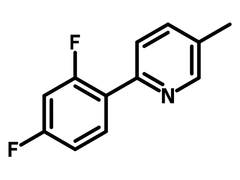2-(2,4-Difluorophenyl)-5-methylpyridine
CAS Number 583052-21-5
Chemistry Building Blocks, Fluorinated Building Blocks, Heterocyclic Building Blocks, Materials, MonomersA difluorinated heterocyclic building block
As cyclometalating ligand to form coordinative complexes in application of OLEDs, DSSCs and photocatalysis reactions
Specifications | MSDS | Literature and Reviews
2-(2,4-Difluorophenyl)-5-methylpyridine (DFPMPy), CAS number 583052-21-5, is a difluorinated heterocyclic derivative of arylpyridine with enhanced solubility by the methyl group. DFPMPy is often used as a cyclometalating ligand with the nitrogen electron lone pair and the delocalized π-electron cloud in the benzene ring being coordinated to a metal center. The metal-ligand complexes have demonstrated excellent photocatalytic capability in visible-light photoredox reactions. During the photoredox process, an electron migrates from the metal center to the ligands, also known as metal-ligand charge transfer (MLCT) after irradiation as the complex reaches the excited state. After the single-electron transfer, the excited complex regains an electron from another reagent and restart the photoredox catalytic cycle.
These complexes are also synthesized for light-emitting electrochemical cells with photoluminescent quantum yield up to 93%. The fluorine-substituents lower the highest occupied molecular orbital (HOMO) energy level resulting shifts in the emission spectrum. Arylpyridine-iridium complexes are widely investigated in water splitting to generate hydrogen. As photosensitizers, these complexes are also used in dye-sensitized solar cells (DSSCs).
Multiple functional groups
For facile synthesis
Fluorinated phenylpyridine building block
For drug discoveries, solar cells, and photocatalists
Worldwide shipping
Quick and reliable shipping
High purity
>97% High purity
General Information
| CAS Number | 583052-21-5 |
| Chemical Formula | C12H9F2N |
| Full Name | 2-(2,4-Difluorophenyl)-5-methylpyridine |
| Molecular Weight | 205.21 g/mol |
| Synonyms | DFPMPy |
| Classification / Family | Pyridine derivatives, Fluorinated building blocks, Heterocyclic building block, Dyes, DSSCs, Photocatalyst ligands, OLEDs |
Chemical Structure

Product Details
| Purity | >97% |
| Melting Point | Tm = 55 °C |
| Appearance | White/off-white to yellow to light brown powder/crystal |
MSDS Documentation
2-(2,4-Difluorophenyl)-5-methylpyridine MSDS Sheet
Literature and Reviews
-
Visible light driven generation and alkyne insertion reactions of stable bis-cyclometalated Pt(IV) hydrides, D. Poveda et al., Chem. Sci., 11, 12095–12102(2020); DOI: 10.1039/d0sc04879h.
-
Cationic iridium (III) complexes bearing ancillary 2,5-dipyridyl(pyrazine) (2,5-dpp) and 2,2’:5’,2’’- terpyridine (2,5-tpy) ligands: synthesis, optoelectronic characterization and light-emitting electrochemical cells, K. Hasan et al.,
Dalton Trans., 43, 13672-13682(2014); DOI: 10.1039/C4DT02100B.
-
Generation of phosphoranyl radicals via photoredox catalysis enables voltage−independent activation of strong C−O bonds, E. Stache et al., ACS Catal., 8(12), 11134–11139(2018); DOI: 10.1021/acscatal.8b03592.
